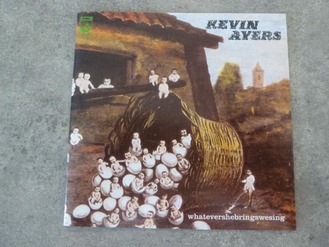Tuesday, 16 April 2013

While The Whole World didn’t last, and, on the surface you wouldn’t have expected it to, David Bedford and Mike Oldfield stayed in the picture for the 1971 sessions that produced Kevin Ayers’ third, and most acclaimed album. In between Shooting at the Moon and Whatevershebringswesing, Ayers had been gigging across Europe with Daevid Allen's band, which explains the presence of saxophonist Didier Malherbe after the departure of Lol Coxhill,
Having worked through Joy of a Toy and Shooting at the Moon the collision of disparate styles hardly comes as a surprise, but here the different styles work together better than they had in the past, from the symphonic notes that start There is Loving > Among Us > There is Loving through to the end of the Didier Malherbe flute solo on Lullaby, with plenty of territory covered in between.
The Whatever sessions started before the demise of The Whole World, which accounts for the David Bedford writing credit (Among Us) stuck in the middle of the two slices of Ayers’ There Is Loving. There’s a fair slice of similar vibe to Pink Floyd’s Atom Heart Mother here, in Bedford’s symphonic, brass heavy orchestral arrangement, but after an avowedly experimental beginning Margaret turns out to be a rather straightforward ballad, intimate in a perfectly romantic setting with understated orchestration.
From there light and shade factors and what comes next probably explain the lightweight New Orleans vibe that runs through Oh My, three minutes of lightweight before the sombre introduction to Song from the Bottom of a Well, which looks back to The Soft Machine’s Why Are We Sleeping? and forwards to Dr. Dream, four and a half minutes marries an experimental arrangement with Oldfield to the fore with a cryptic lyric Intoned in a creepy voice that sounds like it’s coming from a well, tomb or grave, guttural and brimming with foreboding over a barrage of jarring sound effects and dissonant elements.
And after the subterranean spookiness, Whatevershebringswesing's extended bass solo introduction, swirling female harmonies and languid warmth leads into a prime slice of languid warmth with what’s probably the most accurate summary of Ayers approach to life in the chorus (So let's drink some wine / and have a good time / but if you really want to come through / let the good times have you*) with Wyatt's fragile high-pitched treble warbling away in the background and an extended understated solo from Mike Oldfield. Gorgeous, and, for me, the highlight of the album.
There’s a bit of competition in that department from Stranger in Blue Suede Shoes, another expression of the Ayers approach to things with classic rock and roll references, the hip exile (one imagines) faced with a stuffy maitre d’ in a restaurant with pretensions above its actual station. Catchy, old fashioned rock and roll that Ayers obviously enjoyed, re-recording it a couple of times on subsequent projects.
According to Mike Oldfield Champagne Cowboy Blues came about in two parts. Arriving at Abbey Road to find no one else had bothered to turn up on time, Oldfield and engineer Peter Mew filled the waiting time by putting together a track. You can do a fair bit in an hour and a half if you put your mind to it, and when Ayers finally arrived Oldfield had an entire track: all the overdubbing, the percussion, the guitar and bass and the studio staff singing impromptu lyrics.
* Ayers: “That’s, basically, how I’ve lived my life, that’s my feeling about life."